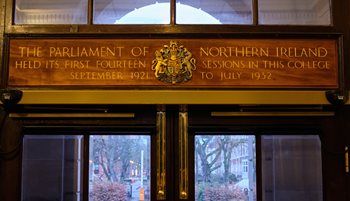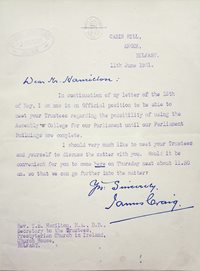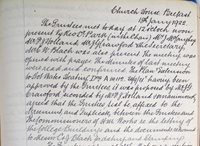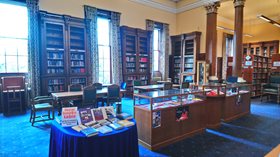.JPG.aspx?width=250&height=173) The exhibition uses the College’s own archive material from the period to tell the story of how a college became a home to a parliament. Online visitors can read letters from Sir James Craig, Northern Ireland’s first Prime Minister, requesting the possibility of using the building, to the negotiations around an appropriate annual rent, which would facilitate the relocation of the College and enable the training of the Church’s ministers to continue - the principal role of the college to this day. Handwritten minutes of meetings, photographs, newspaper reports and other letters can also be viewed.
The exhibition uses the College’s own archive material from the period to tell the story of how a college became a home to a parliament. Online visitors can read letters from Sir James Craig, Northern Ireland’s first Prime Minister, requesting the possibility of using the building, to the negotiations around an appropriate annual rent, which would facilitate the relocation of the College and enable the training of the Church’s ministers to continue - the principal role of the college to this day. Handwritten minutes of meetings, photographs, newspaper reports and other letters can also be viewed.
Joy Conkey, librarian of the College’s Gamble Library, and the creator of the online exhibition, explained that it is a history few know about. “Most people would associate Northern Ireland’s parliament with the impressive building at Stormont, the home of the current Assembly. But very few people probably know that for the first decade of its life, while Stormont was being built, parliament met here. While there is an elegant wooden plaque above the main college entrance that marks the fact, unless you looked up as you left, you probably wouldn’t see it.”
 The Government of Ireland Act 1920 established a ‘Parliament for Northern Ireland’ and a ‘Parliament for Southern Ireland’, based on the two-chamber Westminster model. Only 4 out of the 128 MPs elected to the Parliament of Southern Ireland met on 28 June 1921 in the Royal College of Surgeons, now Government Buildings in Dublin.
The Government of Ireland Act 1920 established a ‘Parliament for Northern Ireland’ and a ‘Parliament for Southern Ireland’, based on the two-chamber Westminster model. Only 4 out of the 128 MPs elected to the Parliament of Southern Ireland met on 28 June 1921 in the Royal College of Surgeons, now Government Buildings in Dublin.
They elected a speaker and went home, the parliament did meet again with the 124 remaining MPs sitting in The Mansion House as the Second Dáil. The Gamble Library on the first floor, where Joy Conkey works, became the home of the Northern Ireland House of Commons, while the College Chapel on the ground floor, was remodelled to accommodate the Parliament’s upper chamber, the Northern Ireland Senate.
 Joy Conkey explained that with the closure of the Gamble Library due to the pandemic, and a click and collect arrangement for library members’ books, a physical exhibition to mark the centenary wasn’t possible. “We have used a number of glass cabinets for different exhibitions over the years, but it wasn’t an option this time. Creating an online exhibition, however, has really worked well and enabled more people to see it.”
Joy Conkey explained that with the closure of the Gamble Library due to the pandemic, and a click and collect arrangement for library members’ books, a physical exhibition to mark the centenary wasn’t possible. “We have used a number of glass cabinets for different exhibitions over the years, but it wasn’t an option this time. Creating an online exhibition, however, has really worked well and enabled more people to see it.”
Ms Conkey continued, “Researching and creating the exhibition, getting to know what was happening here a century ago, especially in the context of where I work every day, was a real privilege. From Sir James Craig’s ‘tentative’ inquiry of 2 May 1921, the eve of Northern Ireland’s creation, when he writes ‘to ascertain whether the College could be made available for use as our new Parliament House’, to its first sitting in September that year, a lot needed to happen.
“The College and the Church needed to agree to the required modifications and other mundane things like insurance and an agreed rent. New arrangements for teaching were also needed. All this and more is in the exhibition. I really hope people will find it interesting, as it offers a fascinating behind the scenes insight into a period of time in the life of our College, but also the history of Northern Ireland itself,” she said.
 A letter dated 16 June, which is also part of the exhibition, points out that the Government was willing to pay a “generous rent…enough to enable us to take good premises for our Class Rooms adjacent to the University…perhaps also for boarding our Students…’ The College negotiated an annual rent of £8,000, the equivalent of nearly £402,000 today, higher than what the government had originally proposed.
A letter dated 16 June, which is also part of the exhibition, points out that the Government was willing to pay a “generous rent…enough to enable us to take good premises for our Class Rooms adjacent to the University…perhaps also for boarding our Students…’ The College negotiated an annual rent of £8,000, the equivalent of nearly £402,000 today, higher than what the government had originally proposed.
Visitors can also view the minutes of a meeting when College Trustees were informed that the Cabinet would not approve Parliament setting up a bar selling ‘intoxicating liquors’ and how the College ‘need have no anxiety whatsoever on that score’ as they would have ‘the hearty support of Sir James Craig in opposing any suggestion’.
-21-September-1921.JPG.aspx?width=250&height=212) The Parliament of Northern Ireland made the College its home for the next 11 years, meeting for the first time on 20 September 1921 and leaving on 31 July 1932. Classes returned to the building that October and a month later, the Prince of Wales, the future King Edward VIII, opened the new Parliament Buildings at Stormont.
The Parliament of Northern Ireland made the College its home for the next 11 years, meeting for the first time on 20 September 1921 and leaving on 31 July 1932. Classes returned to the building that October and a month later, the Prince of Wales, the future King Edward VIII, opened the new Parliament Buildings at Stormont.
Encouraging visitors to view the online exhibition, Principal of Union Theological College, Rev Professor Gordon Campbell, said, “The exhibition details the little-known history of what happened behind the scenes to enable Northern Ireland’s first parliament to meet here one hundred years ago. I found it informative and I’d like to thank Joy for all her hard work in creating it. History is often about buildings and the exhibition sets out, in a fascinating way, how our College played its part in Northern Ireland’s early political history.
 “History is also about people, and while the MPs and Senators who met here made their own impact on Northern Ireland’s political life, the College’s students of that time continued their theological training just across the road, in University Square. They also went on to impact people and places through their ministry, the length and breadth of Ireland and farther afield - wherever God called them. A century on, as part of the Christian community of faith, the College still trains and equips ministerial students for effective ministry within and beyond PCI, as well as preparing all its students to make positive and lasting contributions in our society and across the world.”
“History is also about people, and while the MPs and Senators who met here made their own impact on Northern Ireland’s political life, the College’s students of that time continued their theological training just across the road, in University Square. They also went on to impact people and places through their ministry, the length and breadth of Ireland and farther afield - wherever God called them. A century on, as part of the Christian community of faith, the College still trains and equips ministerial students for effective ministry within and beyond PCI, as well as preparing all its students to make positive and lasting contributions in our society and across the world.”
Acknow-21-September-1921.JPG.aspx?width=250&height=202) ledging the College’s historic role in events one hundred years ago, in September the Presbyterian Church in Ireland will mark the centenary of the establishment of Northern Ireland and the partition of Ireland, by hosting its own significant event at the College.
ledging the College’s historic role in events one hundred years ago, in September the Presbyterian Church in Ireland will mark the centenary of the establishment of Northern Ireland and the partition of Ireland, by hosting its own significant event at the College.
You can view the online exhibition here.
Photos (1) Union Theological College, established in 1853 as the Assembly's College, become Union Theological College in 1978 when it merged with PCI's other theological institution, Magee College in Londonderry (2) the commemorative wooden plaque above the main college doors (3) dated 11 June 1921, one of a number of letters from Sir James Craig, Northern Ireland's first Prime Minister, moving the process of establishing the parliament at the college forward (4) Minutes of a meeting of the college trustees from 18 January 1922 detailing the unanimous agreement to 'the letting of the college buildings...[to]...the Commissioners of H.M. Works' (5) a clipping from the Belfast Telegraph, 21 September 1921, showing the Northern Ireland House of Commons the day after its first sitting in The Gamble Library (6) the libray today and (7) another clipping showing the chamber of the Northern Ireland Senate, which met in the College Chapel from 1921 to 1932.